Learning Processing
A Beginner’s Guide to Programming Images, Animation,
and Interaction
�
Learning
Processing
A Beginner’s Guide to
Programming Images,
Animation, and Interaction
Second Edition
Daniel Shiffman
�
Morgan Kaufmann Publishers is an imprint of Elsevier
30 Corporate Drive, Suite 400, Burlington, MA 01803, USA
Copyright © 2008, 2015 Elsevier Inc. All rights reserved.
Designations used by companies to distinguish their products are often claimed as trademarks or registered trademarks.
In all instances in which Morgan Kaufmann Publishers is aware of a claim, the product names appear in initial capital or
all capital letters. All trademarks that appear or are otherwise referred to in this work belong to their respective owners.
Neither Morgan Kaufmann Publishers nor the authors and other contributors of this work have any relationship or
affiliation with such trademark owners nor do such trademark owners confirm, endorse, or approve the contents of this
work. Readers, however, should contact the appropriate companies for more information regarding trademarks and any
related registrations.
No part of this publication may be reproduced, stored in a retrieval system, or transmitted in any form or by any means—
electronic, mechanical, photocopying, scanning, or otherwise—without prior written permission of the publisher.
Permissions may be sought directly from Elsevier’s Science & Technology Rights Department in Oxford, UK: phone:
(+44) 1865 843830, fax: (+ 44) 1865 853333, E-mail: permissions@elsevier.com. You may also complete your request
online via the Elsevier homepage (http://www.elsevier.com) by selecting “Support & Contact” then “Copyright and
Permission” and then “Obtaining Permissions.”
Library of Congress Cataloging-in-Publication Data
A catalog record for this book is available from the Library of Congress.
ISBN: 978-0-12-394443-6
For information on all Morgan Kaufmann publications, visit our website at www.mkp.com or www.books.elsevier.com
Printed in the United States of America.
�
In memoriam
Red Burns was born in 1925 in Ottawa, Canada. In 1971, after having already led several full lives, she
founded the Alternate Media Center at New York University. The center later became the Interactive
Telecommunications Program (ITP) where she served as chair from 1982 until 2010. I met Red in 2001,
when she introduced the program to me in what was likely her 20th year of student orientation. I was
rather terrified of Red, but it didn’t last. I quickly discovered her warmth, and over the next twelve years I
was incredibly lucky to experience her fierce intelligence, five-word e-mails, and unwavering
protectiveness of humanity over technology. People were always at the center of her thinking, and the
tools (like the one taught in this book) were just a means for expression and communication. The ideas in
this book were born from her mentorship and friendship. As the ITP saying goes, “Red Burns Changed
My Life.”
http://itp.nyu.edu/redburns/
�
Acknowledgments
In the fall of 2001, I wandered into the Interactive Telecommunications Program in the Tisch School of
the Arts at New York University, having not written a line of code since the early 1980s, when I’d done
some experimenting in BASIC on an AppleII+. There, in a first semester course entitled “Introduction to
Computational Media,” I discovered programming. ITP has been my home ever since. Without the
inspiration and support of the department, this book would never have been written.
Red Burns, the department’s founder, encouraged and championed me for my first ten years at ITP.
Sadly, she passed away in August 2013; this book is dedicated to her legacy. Dan O’Sullivan was the first
to suggest that I try a course in Processing, giving me a reason to start putting together programming
tutorials. Shawn Van Every sat next to me in the office throughout the majority of the writing of this
book’s first edition, providing helpful suggestions, code, and a great deal of moral support along the way.
Tom Igoe’s work with physical computing provided inspiration for this book, and he was particularly
helpful as a resource while putting together examples on network and serial communication. And it was
Clay Shirky who I can thank for stopping me in the hall one day to tell me I should write a book in the
first place. Clay also provided a great deal of feedback on early drafts of the first edition.
All of my fellow computational media teachers at ITP have provided helpful suggestions and feedback
along the way: Danny Rozin (the inspiration behind Chapters 15 and 16), Mimi Yin, Lauren McCarthy
(whose innovative work developing p5.js has opened my eyes up to the world of JavaScript and the web),
Amit Pitaru (who helped in particular with the first edition’s chapter on sound), Nancy Lewis, James Tu,
Mark Napier, Chris Kairalla, Luke Dubois, Roopa Vasudevan, Matt Parker, Heather Dewey-Hagborg,
and Jim Moore (who was my teacher for that first semester course!). My gratitude goes to the following
ITP full-time faculty members for continuously offering their insight and fortitude throughout the
writing of this book: Marianne Petit, Nancy Hechinger, Marina Zurkow, Katherine Dillon, Eric
Rosenthal, Gabe Barcia-Colombo, and Benedetta Piantella Simeonidis. And my full appreciation goes to
the rest of the faculty and staff at ITP who have made this possible: George Agudow, Edward Gordon,
Midori Yasuda, Rob Ryan, John Duane, Marlon Evans, Tony Tseng, Matthew Berger, Karl Ward, and
Megan Demarest.
The students of ITP, too numerous to mention, have been an amazing source of feedback, having used
much of the material in this book in trial runs for various courses. I have stacks of pages with notes
scrawled in the margins, as well as a vast archive of email exchanges with corrections, comments, and
generous words of encouragement, all of which were integral to the development of this book’s ideas.
I’m also indebted to the energetic and supportive community of Processing programmers and artists. I’d
probably be out of a job if it weren’t for Casey Reas and Ben Fry who created Processing, to say the least.
I’ve learned half of what I know simply from reading through the Processing source code; the elegant
simplicity of the Processing language, website, and IDE has made programming accessible and fun for me
and all of my students. I’ve received advice, suggestions, and comments from many Processing
programmers including Andres Colubri, Scott Murray, Florian Jennet, Elie Zananiri, Scott Garner,
Manindra Mohanara, Jer Thorp, Marius Watz, Robert Hodgin, Golan Levin, Tom Carden, Karsten
Schmidt, Ariel Malka, Burak Arikan, and Ira Greenberg. The following teachers were also helpful in test-
driving early versions of the first edition in their courses: Hector Rodriguez, Keith Lam, Liubo Borissov,
Rick Giles, Amit Pitaru, David Maccarella, Jeff Gray, and Toshitaka Amaoka.
�
Acknowledgments
x
Peter Kirn and Douglas Edric Stanley provided extraordinarily detailed comments and feedback during
the first edition’s technical review process; the book is a great deal better than it would have been without
their efforts. Demetrie Tyler did a tremendous job working on the original visual design of the cover and
interior of the book. And a thanks to David Hindman, who helped me organize the original screenshots
and diagrams. My thanks to Rich Hauck who developed the website for the first edition.
I’d also like to thank everyone at Morgan Kaufmann/Elsevier who worked on producing the first edition:
Gregory Chalson, Tiffany Gasbarrini, Jeff Freeland, Danielle Monroe, Matthew Cater, Michele Cronin,
Denise Penrose, and Mary James.
For the second edition, I am incredibly grateful to everyone at Morgan Kaufmann/Elsevier and O’Reilly
who were supportive of my choice in using the Atlas publishing platform (https://atlas.oreilly.com/) to
create this book.
Using Atlas allowed me to have a more fluid process and involve lots of contributors with feedback and
advice. Wilm Thoben, Seth Kranzler, and Jason Sigal all provided sound feedback and edits on Chapter
20: Sound. Mark Sawula, Yong Bakos, and Kasper Kasperman read PDFs as they were generated and
gave excellent critique and feedback. J. David Eisenberg acted as a de-facto technical editor, offering
numerous and terrific suggestions for improving explanations and examples. A special thanks goes to
Johanna Hedva who copy-edited almost the entire book during elaborate layout transformations. In
addition, several key content changes exist because of her keen eye.
From Elsevier, Todd Green went above and beyond in working out the details of the complex
collaboration with O’Reilly and Atlas. Thanks also to Charlie Kent and Debbie Clark for their help in
facilitating production details. I’d like to say, in general, that the Atlas platform and the team at O’Reilly
are terrific to work with: This book has all sorts of strange layout quirks, and it’s amazing that the entire
end product is generated from an HTML file using CSS and XSLT for layout. Thanks to Andrew
Odewahn, Rune Madsen, Sanders Kleinfeld, Dan Fauxsmith, and Adam Zaremba for giving me early
access to Atlas and teaching me its magic. Thanks to Rebecca Demarest for her help and advice with
illustrations, and Ron Bilodeau for his feats of CSS. Last, but the opposite of least, I’d like to thank
Kristen Brown who listened thoughtfully to every, single, tiny detail I asked about and applied the exact
skills I lacked, knowing how to prioritize and keep a schedule to make sure this book actually met its
deadline. You can see the scale of her contribution in this book’s Github repo’s pulse.
Most importantly, I’d like to thank my wife, Aliki Caloyeras; my children, Elias and Olympia; my
parents, Doris and Bernard Shiffman; and my brother, Jonathan Shiffman, for their moral support,
advice, and encouragement, not only in the second edition of this book, but in everything else.
�
Introduction
What is this book?
This book tells a story. It is a story of liberation, of taking the first steps toward understanding the
foundations of computing, writing your own code, and creating your own media without the bonds of
existing software tools. This story is not reserved for computer scientists and engineers. This story is for
you.
Who is this book for?
This book is for the beginner. If you have never written a line of code in your life, you’re in the right place.
No assumptions are made, and the fundamentals of programming are covered slowly, one by one, in the
first nine chapters of this book. You do not need any background knowledge besides the basics of
operating a computer — turning it on, browsing the web, launching an application, that sort of thing.
Because this book uses Processing (more on Processing in a moment), it’s especially good for someone
studying or working in a visual field, such as graphic design, painting, sculpture, architecture, film, video,
illustration, web design, and so on. If you’re in one of these fields (at least one that involves using a
computer), you’re probably well-versed in a particular software package, possibly more than one, such as
Photoshop, Illustrator, AutoCAD, Maya, After Effects, and so on. The point of this book is to release
you, at least in part, from the confines of existing tools. What can you make, what can you design, if,
instead of using someone else’s tools, you create your own?
If you already have some programming experience but are interested in learning about Processing, this
book could also be useful. The early chapters will provide you with a quick refresher (and solid
foundation) for the more advanced topics found in the second half of the book.
What is Processing?
Let’s say you’re taking Computer Science 101, perhaps taught using the Java programming language.
Here is the output of the first example program demonstrated in class:
�
xii
Introduction
Traditionally, programmers are taught the basics via command line output:
1. TEXT IN → You write your code as text.
2. TEXT OUT → Your code produces text output on the command line.
3. TEXT INTERACTION → The user can enter text on the command line to interact with the
program.
The output “Hello, World!” of this example program is an old joke, a programmer’s convention in which
the text output of the first program you learn to write in any given language says “Hello, World!” It first
appeared in a 1974 Bell Laboratories memorandum by Brian Kernighan entitled, “Programming in C: A
Tutorial.”
The strength of learning with Processing is its emphasis on a more intuitive and visually responsive
environment, one that is more conducive to artists and designers learning programming.
1. TEXT IN → You write your code as text.
2. VISUALS OUT → Your code produces visuals in a window.
3. MOUSE INTERACTION → The user can interact with those visuals via the mouse (and more as
you will see in this book!).
Processing’s “Hello, World!” might look something like this:
�
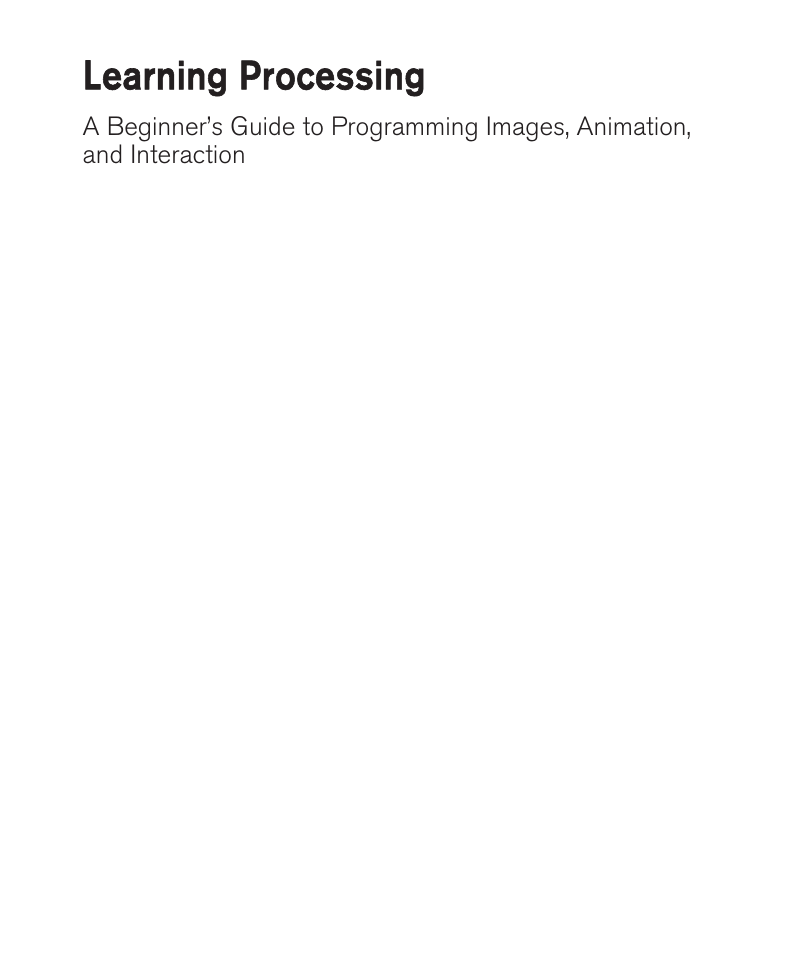
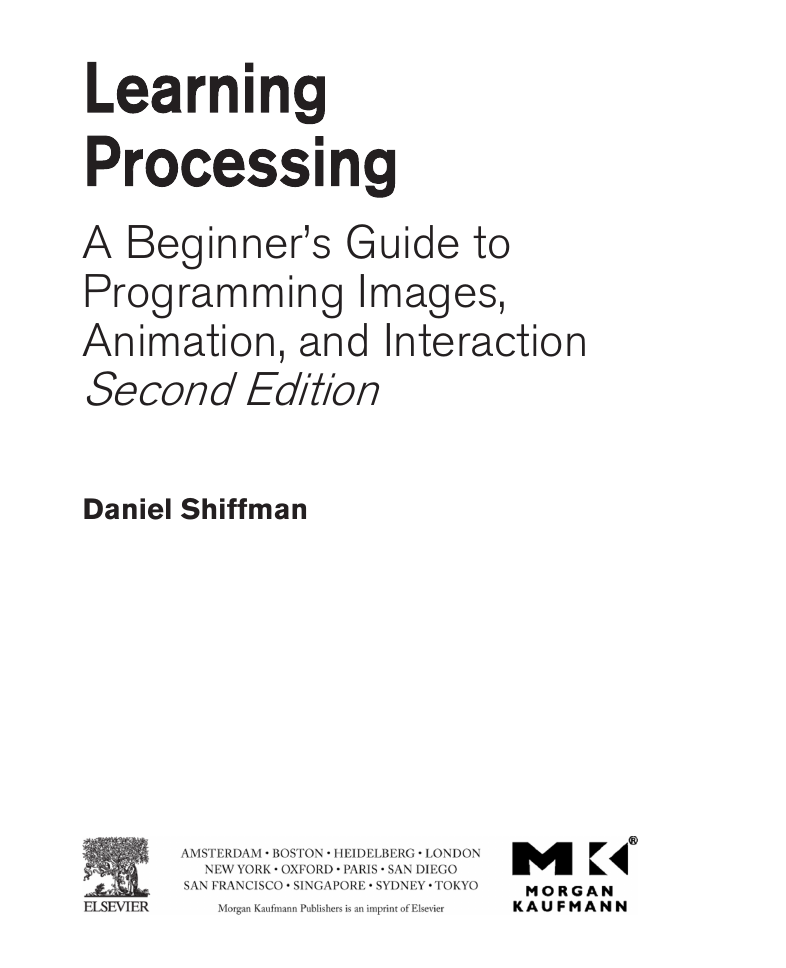

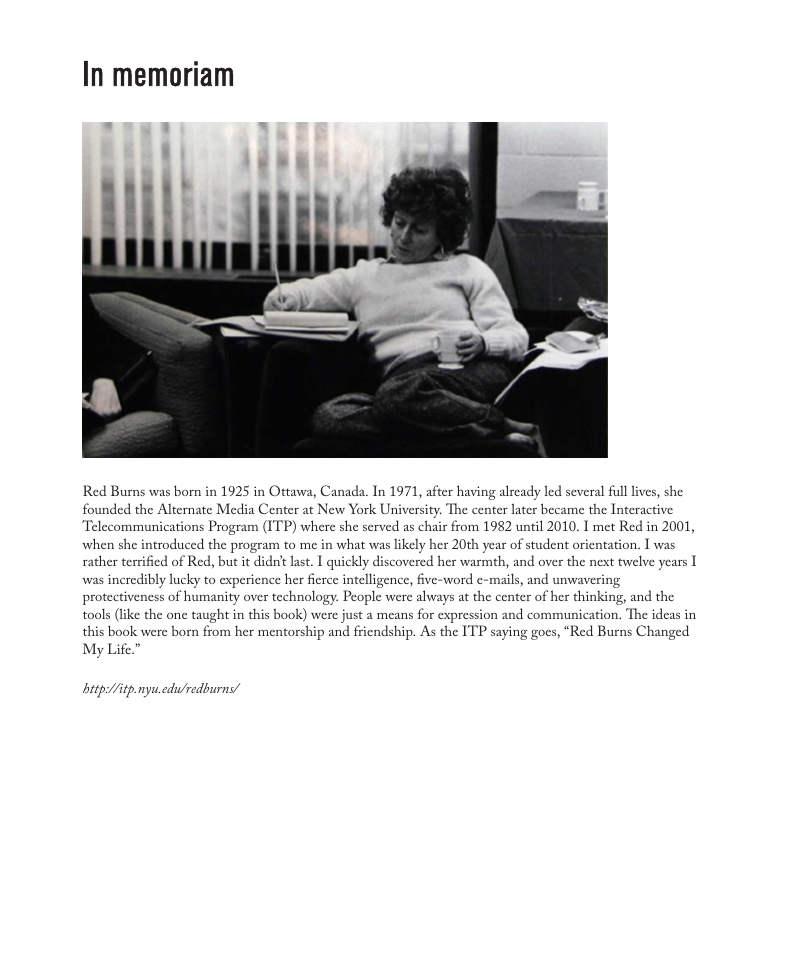

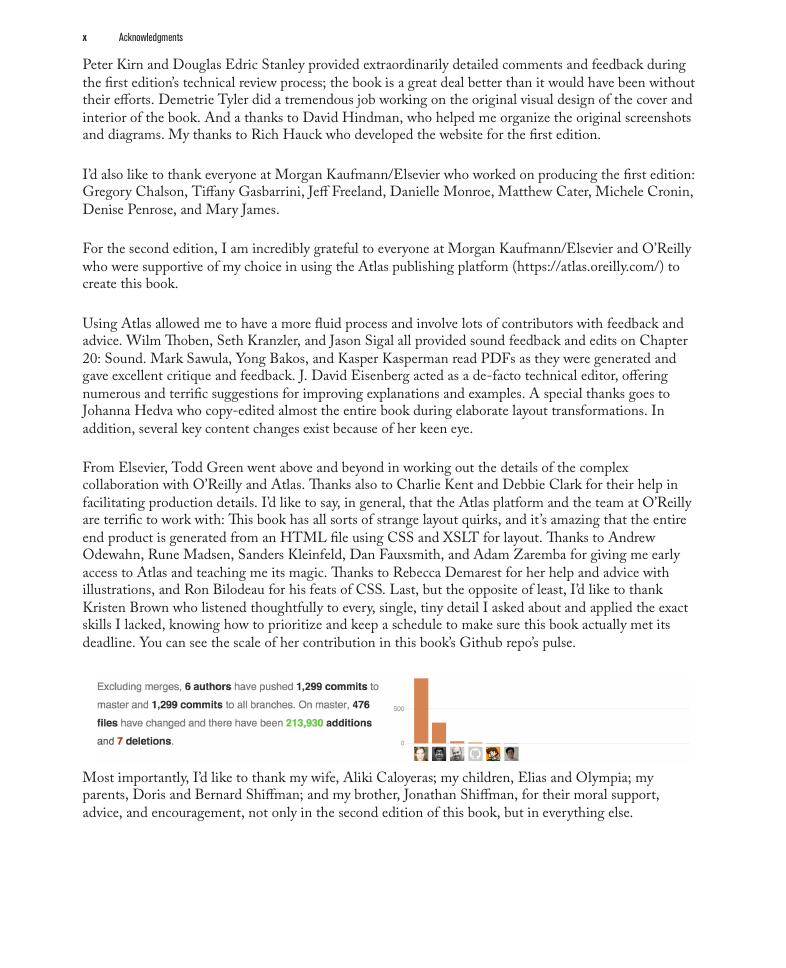
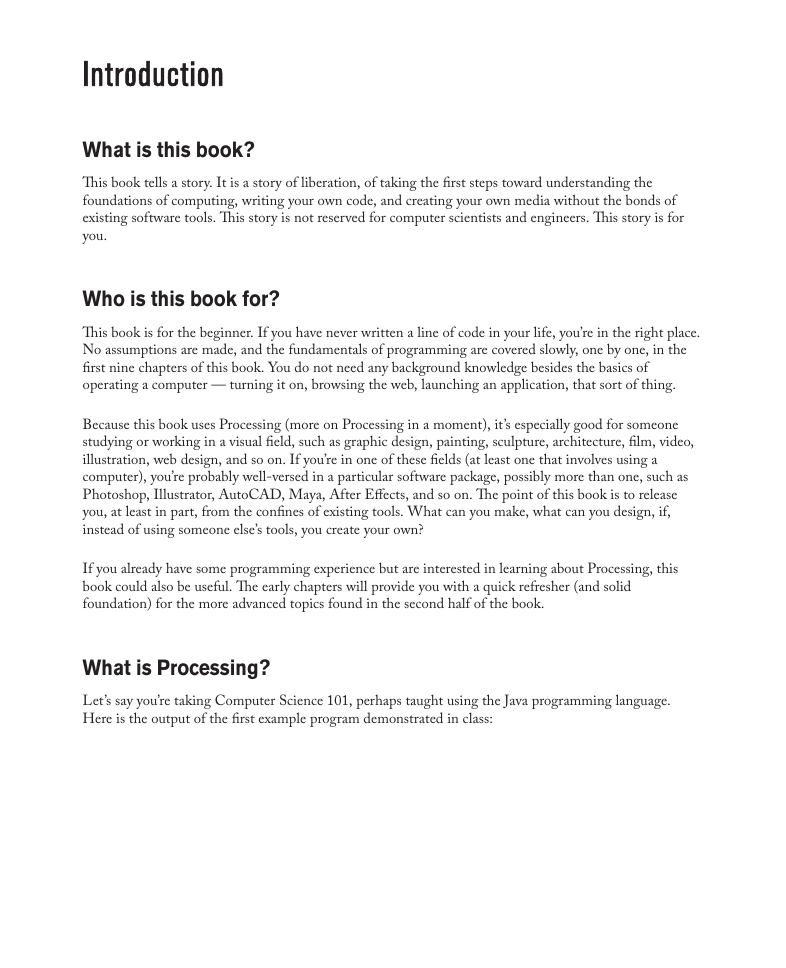









 2023年江西萍乡中考道德与法治真题及答案.doc
2023年江西萍乡中考道德与法治真题及答案.doc 2012年重庆南川中考生物真题及答案.doc
2012年重庆南川中考生物真题及答案.doc 2013年江西师范大学地理学综合及文艺理论基础考研真题.doc
2013年江西师范大学地理学综合及文艺理论基础考研真题.doc 2020年四川甘孜小升初语文真题及答案I卷.doc
2020年四川甘孜小升初语文真题及答案I卷.doc 2020年注册岩土工程师专业基础考试真题及答案.doc
2020年注册岩土工程师专业基础考试真题及答案.doc 2023-2024学年福建省厦门市九年级上学期数学月考试题及答案.doc
2023-2024学年福建省厦门市九年级上学期数学月考试题及答案.doc 2021-2022学年辽宁省沈阳市大东区九年级上学期语文期末试题及答案.doc
2021-2022学年辽宁省沈阳市大东区九年级上学期语文期末试题及答案.doc 2022-2023学年北京东城区初三第一学期物理期末试卷及答案.doc
2022-2023学年北京东城区初三第一学期物理期末试卷及答案.doc 2018上半年江西教师资格初中地理学科知识与教学能力真题及答案.doc
2018上半年江西教师资格初中地理学科知识与教学能力真题及答案.doc 2012年河北国家公务员申论考试真题及答案-省级.doc
2012年河北国家公务员申论考试真题及答案-省级.doc 2020-2021学年江苏省扬州市江都区邵樊片九年级上学期数学第一次质量检测试题及答案.doc
2020-2021学年江苏省扬州市江都区邵樊片九年级上学期数学第一次质量检测试题及答案.doc 2022下半年黑龙江教师资格证中学综合素质真题及答案.doc
2022下半年黑龙江教师资格证中学综合素质真题及答案.doc